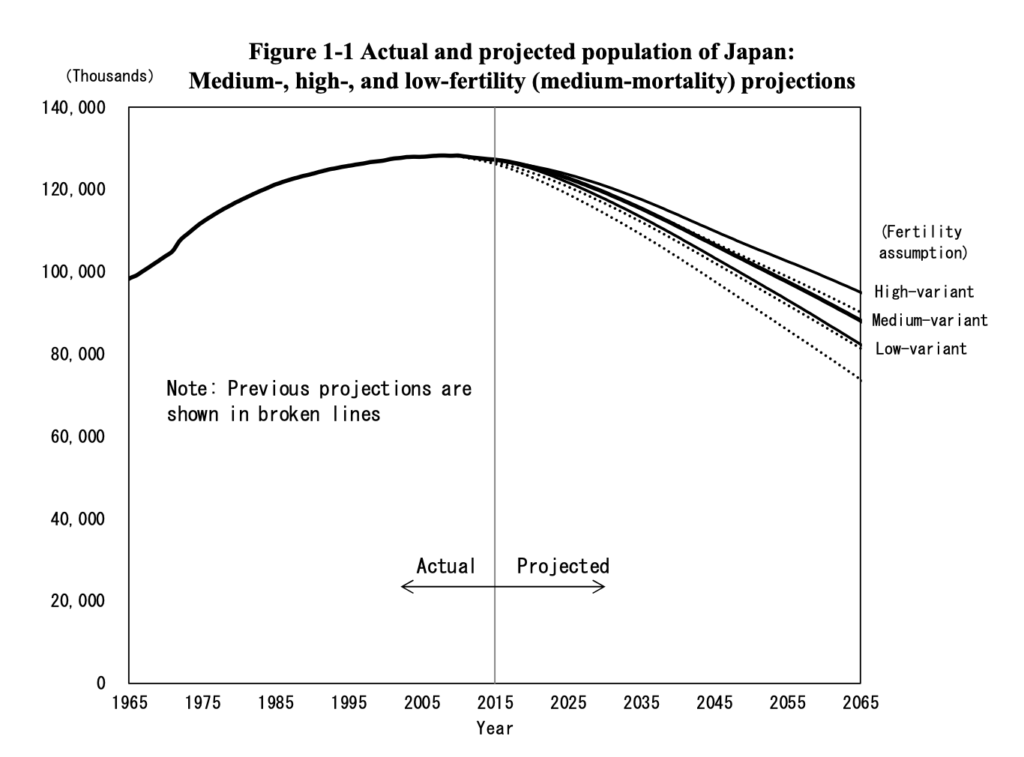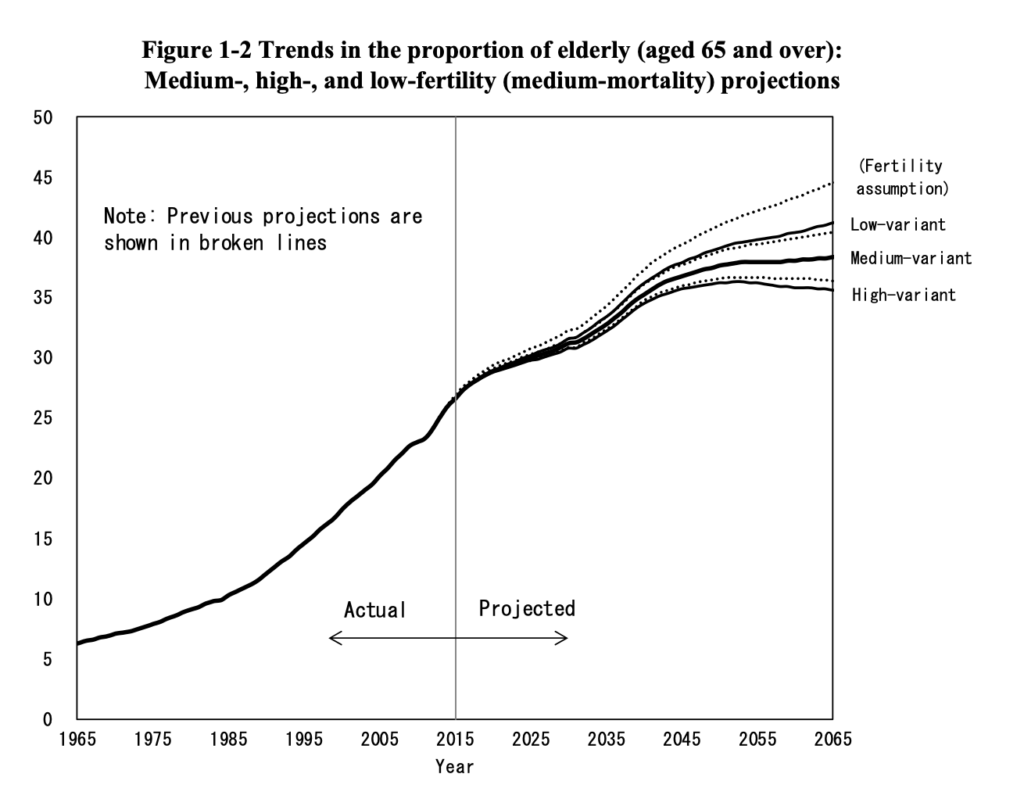There’s a certain amount of hand-wringing these days about “demographic collapse,” or, declining population due to low fertility rates. Virtually the whole world these days has fertility rates below replacement rates of about 2.1 children per woman. Africa has been the exception; but fertility is plummeting there too, and may fall below 2.0 in not very many years.
Concern has been particularly acute for the developed countries, including the US, Europe and developed Asia. We can include here China, which has a very low fertility rate (some people think the official numbers are dramatically overstated).
This has led to a lot of worrying. Much of this, it seems to me, is vague association. In the past, declines in population were commonly associated with all kinds of bad things, such as plagues. Sometimes, factors such as deforestation, desertification or salinization of the soil might cause a once-prosperous region to be no longer habitable. A big factor has been oppressive governments and poor economic policy: eventually, people will either die off from famine (China under communism), or migrate elsewhere (Venezuela today). In other words, population decline has often been accompanied by a decline in economic prosperity. So, we today have vague but powerful associations along these lines.
But, today’s demographic decline is from entirely different factors. Mostly, it is a result of prosperity. The most prosperous places (Singapore, for example) have the lowest fertility rates. There are a number of reasons for this, which you can either guess or read about elsewhere. One factor is that children become a lot more expensive due to extended educations, while their economic benefits to parents decline. Children were once useful on farms, and in old age, grown children were the primary supports of elderly that were no longer able to be as productive as in the past. Today, we don’t farm much anymore, and we simply tax other people’s children via Social Security-type programs. Developed countries have a strong tendency toward independent households for seniors. A lot of children died in the past. As healthcare advances extended lives, people adjusted the number of children they had downwards, but this was with a lag of decades.
Fertility rates below replacement values (2.1) will lead to a slow decline in population. But, the process is pretty slow. For example, here is a population projection for Japan, which is usually held out as a forerunner in these things:

These demographic projections usually turn out to be pretty accurate, because trends in fertility tend to change quite slowly, and all the adults of the future are already born today. (Nevertheless, projections were recently adjusted upwards, with the old projections shown in dotted lines.)

Perhaps more important is a trend toward a higher percentage of seniors in the population. This is something really new. Never before has any human society had so many seniors.
Naturally, with declining overall population, and a growing share of seniors, the working age population would be falling at a faster rate than the population as a whole. Although the total population for Japan has hardly begun to decline, the working age population (ages 15-64) has already had a pretty big drop.


But, population itself does not make people wealthy and prosperous. The world is full of very populous places that are dirt poor. India and China used to be good examples here, although they have been doing better recently. But, the population of Nigeria is now 212 million. Did that make Nigerians rich? Nope.
On the other had, the world is also full of rather smallish places that are wealthy, including Singapore, Ireland, Iceland, Luxembourg, and Canada (by population).
It’s not the population, but the productivity that makes people wealthy. Economics 101.
If Japan in the future had half the population, but worker productivity was higher, then incomes and prosperity would be higher, not lower, despite the population decline. Plus, in anywhere seriously crowded, a smaller population can lead to greater effective wealth per person. Mostly this is for limited resources such as land. Fewer people means more land per person. It was a big deal in the agrarian past, although not such a big deal today. After a big plague, the survivors inherited all the property of the deceased. Often, they piled up a lot of wealth as a result. But, that would be more of a factor after a sudden decline in population, not these long, slow declines. For example, if the population of Japan fell in half tomorrow, then houses and apartments would be very cheap, and the survivors would have their pick of nifty places to live. However, if the process is drawn over 50 years, the natural decay of buildings, or changing economic situations that make once-valuable properties no longer so valuable, would tend to keep things in line with the population, and there would be no big windfalls. Over the next 50 years, nearly every residential or commercial property, including all factories, will be replaced; and whatever new that is built will fit the needs of that time.
If you look at productivity over time, or economic growth, or GDP/capita, or incomes etc. we find that it can go up or down pretty quickly. In other words, economic policy — for better or for worse — will have a much greater effect on productivity and thus incomes and prosperity, than any demographic effects. In other words, the Japan of the future, which may have half the population, will be prosperous or not due almost entirely to economic policy. It is no different than during periods of rising population. During the 1950s and 1960s, Japan had a quickly rising population, and incomes soared. India also had a quickly rising population; and was mired in grinding poverty. Half the population in Japan, or about 60 million people, is still a lot. It is still more than the agricultural base of Japan can sustain. Japan would continue to be dependent on imports of food. It is still about double the population of California, which has about the same land area. It is about the population of 1930.

Nevertheless, if we take GDP to be a combination of the number of workers * the productivity per worker, then overall GDP might be a little depressed if the number of workers is falling by about 1% per year, instead of rising by about 1%. That is a combined 2%, which is significant — even assuming that productivity, and thus incomes, are unchanged in either scenario.
But, why is it significant? Significant to whom? The Japanese worker? We already indicated that productivity and wages were unchanged. Does the Japanese worker care if the population drops 1%, but his income is fine? Economic policy — for better or worse — has a much bigger effect on the Japanese worker’s well-being than these slow changes in demography. His income might go up or down, a lot, instead of remaining stable (or growing at an unchanged slow rate).
Mostly, it is significant to the government. It is significant not because you can’t have a completely prosperous society with a declining population, but that many government institutions were set up in the 1930-1970 period, of expanding populations. They aren’t designed for the present situation. This will have to be fixed. But, government being what it is, they would rather go off the cliff with their stupid programs that don’t work, rather than change things.
For example, we now have a pattern of seniors being supported by State pensions (Social Security). This is a product of the 1930-1960 period, a time of expanding populations in the developed world. There were more and more workers, but not so many seniors.

Obviously, a program like this isn’t going to work when a large part of the population is seniors. But, rather than creating new institutions that do work, governments and their advisors would rather just talk about disasters, and pile new mistakes on their old dysfunctional systems. For example, one obvious response would be to raise taxes. But, that would impair the productivity of the workers. It would lead to economic decline. Now, let’s figure this out:
Fewer workers * less productivity per worker
What does Economics 101 say? Shrinking productivity and a shrinking economy. So, how are you going to pay for all those seniors when your productivity and real income is going down? Doesn’t work very well does it.
Rather, the solutions should be along these lines:
- More productivity per worker, which means higher incomes, so that they are better able to support seniors. This means good economic policy, which also means: Lower Taxes. Over fifty years, good economic policy can have a huge effect on incomes. With good economic policy, incomes in Japan might be double where they would be with mediocre economic policy. It would be a lot easier to pay for your parents’ retirement if you have double the income, don’t you think?
- More reliance upon adult children rather than taxing other people’s children through State Pension programs. This is the way it was for thousands of years, until about 50 years ago.
- Lower costs per Senior (probably living in children’s households). This would probably include limiting medical expenditures on Seniors with little useful lifespan left.
- More productivity per Senior. Even if Seniors are not as productive as working-age people, nevertheless they can be somewhat productive. Their productivity does not have to fall to zero in “retirement.” They could be productive in the informal economy, probably within the household, perhaps taking a role in childcare and education. One big role for Seniors, I think, will be caring for other Seniors. Seniors age 65-75 are capable of cooking and cleaning, and can support not only themselves but other Seniors 75+ who have become more impaired due to age. For example, you could have a Senior Community with an effective contract that a member would do work Age 65-75 and in return, be taken care of Age 75-85 (death).
This is sensible and not very hard to figure out. But, it would require completely new institutions and ways of doing things — which are, mostly, the old ways of doing things, before we got the idea that we would change all historical precedent by expecting Seniors to live in independent households at taxpayer expense.
So, go do that.

